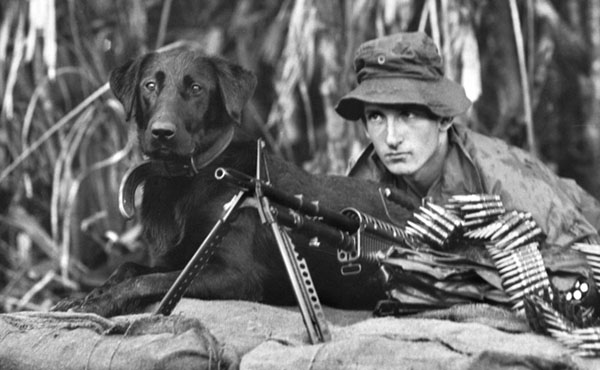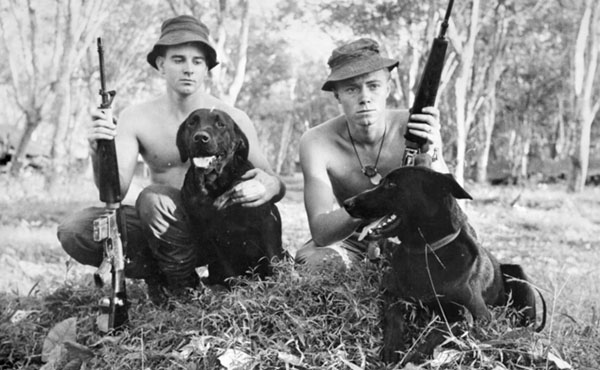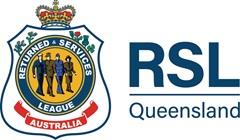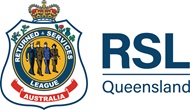
Every dog has its day
07 June 2021- ANZACspirit
- Mateship
- Veteran stories
On National Military Working Dog Day, we honour all war dog teams who have served in the Australian Defence Force.
Military working dogs have played a role in Australia’s armed forces since World War I, serving alongside Defence personnel all over the world.
Lieutenant Colonel George Hulse OAM specialised in training war dogs. He first encountered them while serving in Vietnam and went on to establish the Explosive Detection Dog Wing at Sydney’s School of Military Engineering, as well as the War Dogs Association.
He clarifies some of the terminology used to describe military working dogs and their handlers.
“The term doggy really means the human being. So, if I talk in terms of this doggy or that doggy, I'm talking about a human being.
“And when we talk about a dog team, we're talking about one dog and one handler.
“So, a dog and a doggy are a dog team.”
A DANGEROUS JOB

George says that dog teams are usually the eyes and ears of a patrol.
“The main feature of a war dog team is that they’re the folk who get out in front of the combat soldiers.
“If you can imagine an infantry section of a forward scout being the point man of the whole army, he's an infantry soldier with exceptional skills in being able to see the enemy and enemy signs.
“If things start getting tough for that soldier, they will call in a war dog team, and the dog and the doggy go in front of that soldier and lead the way.”
According to George, this puts dog teams in a lot of danger.
“The problem is, whereas the forward scout is looking for enemy soldiers peeping round a tree or looking up out of a hole or something like that, the doggy can't do that because he's looking at his dog.
“So, he's totally relying on his dog to let him know that there's something out there that shouldn't be there – and that something can be an enemy soldier, it can be explosive, it can be ammunition, it can be a tripwire – just something that shouldn't be there.
“And the dog gives an indication.”
George explains that soldiers often have just seconds to react to their dog’s indication.
“Sometimes the indication is so fast that the dog handler really can't take his eyes off that dog,” says George.
“If the handler is really worried about what might be out there in front of him, as soon the dog gives an indication, he's got to hit the ground and get out of the way.
“And all the other soldiers behind him, when they see the doggy go down, they have to get out of the way as well.”
THE TALE OF CORPORAL PETER HARAN AND WAR DOG CAESAR

When looking back on Australia’s history of dog teams, George recalls the extraordinary story of Corporal Peter Haran and his war dog Caesar, who served in Vietnam.
“Caesar was never trained to find bombs, mines or explosives, but he was highly trained to find people,” says George.
“He [Peter Haran] went out with Caesar on a job to find the bad guys, and he came up to a T-intersection in a road and the dog went forward – the idea was that the dog should check to see if there's an ambush at the T intersection.
“The dog went round and round in circles and did things that Peter had never seen Caesar do before.
“Every time Peter moved, the dog came and sat on his feet. And so Peter thought, ‘I wonder what's going on?’”
George says that Peter called for some combat engineers to come and investigate.
“Two combat engineers came forward and they went into the T-intersection and picked up a daisy ring of bombs.
“The dog knew that there was something there that he didn't want his boss to tread on.
“He never trained for it, but he knew there was something there that was bad. He wouldn't let his boss move - he sat on his feet, saying, ‘You're not going anywhere, boss’.”
George can appreciate military working dogs more than most people, but he says also it’s important to remember that there’s a human behind every war dog.
“And that’s the problem with everybody, they only see the dog. They don't realise that behind the dog is a highly trained specialist who works in combination with the dog.”
A ceremony for National Military Working Dog Day will be held Monday 07 June at the Military and Service Working Dog National Monument situated at the RSPCA Campus Wacol.
The Ceremony also remembers the sacrifice of Sapper Darren Smith & Explosive Detection Dog Herbie along with Sapper Jacob Moerland who were killed in action in Afghanistan on this day in 2010.
Related News
Loading

